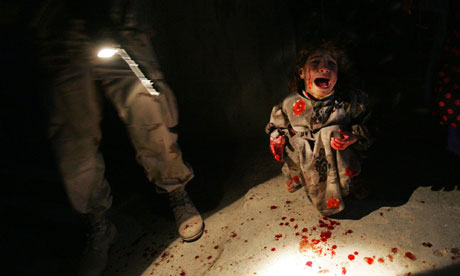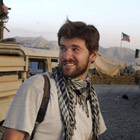Award-winning US photographer lauded for his images of the world's war zones

Chris Hondros, below, and one of his most dramatic images, above, taken in Iraq in 2005. The child’s parents had just been killed by US forces. Photograph: Getty
Chris Hondros, who has died aged 41 from injuries sustained in a grenade attack by Libyan government forces in Misrata, was one of the world's leading contemporary war photographers. His dramatic images from conflicts in Kosovo, Angola, Afghanistan, Iraq, the West Bank and Libya appeared regularly in Newsweek, the New York Times, the Los Angeles Times and the Washington Post. In 2004, his dramatic reportage from Liberia earned him a Pulitzer prize nomination. He was awarded the Robert Capa gold medal by the Overseas Press Club in 2005 for his "exceptional courage and enterprise" while covering the Iraq war, and, in 2007, American Photo magazine named him "Hero of Photography". 

Hondros took what was perhaps his most dramatic series of photographs on 18 January 2005, while embedded with US-led forces in the town of Tal Afar in northern Iraq. At dusk, he captured the shooting of an Iraqi family after their car had failed to stop at an army checkpoint. Both adults, Hussein and Camila Hassan, were killed, but the six children travelling with them survived. In the most famous image from the series, a young girl screams in terror, her clothes and the ground around her feet splattered in blood. She is bathed in a beam of light from a torch carried by the soldier standing guard over her. That photograph was published and broadcast around the world, causing a considerable outcry. It has since become emblematic of the suffering inflicted on civilians caught up in the wars in Iraq and Afghanistan. The most seriously injured Iraqi child, a young boy, was later flown to America for treatment. In a statement, the army extended condolences to the family for the "unfortunate incident". When interviewed about the pictures by the Columbia Journalism Review, Hondros said: "Almost every soldier in Iraq has been involved in some sort of incident like that or another. Their attitude about it was grim, but it wasn't the end of their world. It was, 'well, [I] kind of wished they'd stopped. We fired warning shots. Damn, I don't know why the hell they didn't stop. What're you doing later, you want to play Nintendo? OK.' Just a day's work for them. That stuff happens in Iraq a lot." Hondros was born in New York, where his parents, both child refugees from the second world war, had settled. He grew up in Fayetteville, North Carolina, graduating from Terry Sanford high school in 1988, before studying English literature at North Carolina State University. He obtained a master's degree in visual communications at Ohio University and then began working on the Fayetteville Observer in 1996. "He was highly intellectual, and he connected with people," said Johnny Home, the picture editor who hired him. "Not all photographers make that connection, but the best do, and he was the best. You don't get the picture he got without making that connection." In 1998 Hondros moved to New York, where he lived until his death, and started working as a freelance. As well as covering conflicts abroad, he famously photographed the aftermath of the 11 September attacks in New York in 2001, John Kerry's presidential campaign in 2004, and the devastation caused by Hurricane Katrina in New Orleans in 2005. It was as a war photographer, though, that Hondros excelled, often illustrating, at considerable risk to himself, Capa's famous dictum: "If your pictures aren't good enough, you're not close enough." During the civil war in Liberia, he captured an unforgettable image of a militiaman leaping in the air with joy after firing a grenade at rebel forces from the rocket launcher he is brandishing victoriously. That image helped him earn the Pulitzer nomination. In 2005, he returned to Liberia and found the man in that photograph, who was living in poverty with his wife and young family. The photographer raised money for a laptop computer so that the ex-soldier could pursue his dream of higher education. Hondros took what would become his final photographs among the anti-government rebels in the midst of the fighting in the battle for Misrata in early April 2011. One series of dramatic, close-up shots depicts rebels attempting to take a house occupied by loyalist snipers who are firing from an upstairs room. Again, Capa's famous quote comes to mind and, with it, the risks that war photographers continue to run to capture dramatic images from the frontline of today's war zones. Hondros was killed alongside his friend, Tim Hetherington, a lauded British war photographer and film-maker. They were the first western journalists to be killed in Libya. Once, when asked about his expererience of war photography in Iraq, Hondros said simply: "I went and covered what was in front of me, and did what I could to help people understand what was happening – even when I didn't really understand it myself." He is survived by his mother, Inge, his brother, Dean, and his fiancee, Christina Piaia. The Chris Hondros Fund has been set up to provide scholarships for aspiring journalists and raise awareness of issues surrounding conflict photography.
• Christopher Eric Hondros, photographer, born 14 March 1970; died 20 April 2011
No comments:
Post a Comment